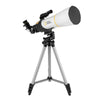If you are on the market for a telescope especially if you are a beginner, there are a few key factors to keep in mind when choosing a telescope. One of the main factors that will determine performance and image quality.
Aperture or Diameter - Determines how much light will allowed to to pass through big end of the telescope.
Price:
You always have to consider your budget and how serious the hobby is to you. Prices can range from 50 to a few thousand dollars. And depending on the goal you are trying to accomplish you won't have to spend a ton of money.
Size:
You also have to take into consideration the size of a unit. Are you looking for something more stationary or would you prefer something that you can travel with.
Right now there are about 4 different types of telescopes. The first and most common would be the refractor. Invented in the 1600's by scientists , mathematician and philosopher Galileo Galilei.
Refractor: Most Common
View deeps sky objects with a wide range of view. Very clean image and versatile day or night viewing
Invented by Issac Newton 1965. This is where the lens takes in light from the larger end of the tube and transfers it to a mirror or the focal point, which can be straight or at an angle to focus beam to the eyepiece. No alignment needed and low maintenance.

Explore One 60mm Refractor Telescope
For instance lets take this Explore One 60mm refractor telescope
which is just perfect for a beginner. Seeing the moon and other celestial objects not an issue brighter objects will have a sharper image vs a faint object which requires more aperture and magnification.
Newtonian Reflector: This will you put you right in the middle as you can view both planetary and deep sky objects. Uses 2 mirrors instead of a lens to focus light in turn giving you a bigger aperture and reducing costs as mirrors can easily be replaced. This will require more alignment as the mirrors my need to be realigned at times due to transporting. Not for day time viewing but prefect for night time viewing.

A good beginner reflector telescope compact , light weight and budget friendly.
National Geographic 76mm Compact Reflector Telescope - 80-20103
Maksutov Cassagrain: Excellent if you just want to view planets. Accredited to inventor Laurent Cassagrain first appearing in 1672. Similar to the reflector design except you have 2 folded mirrors that send focus beams from a covered lens , closed tube on the front, to secondary lens which is then returned in a direct path to the back of the telescope to the eyepiece. They are small and compact in size is size and don't require as much maintenance as a reflector design. Night time viewing only.

Explore FirstLight 127mm Mak-Cassegrain Telescope with Twilight I Mount - FL-MC1271900MAZ01

Dobsanian

A Dobsonian telescope pairs a large-aperture newtonian reflector with a simplified alt-azimuth mount that is easy to assemble and easy to transport. Sized to bring in copious amount of light, these dobsanians are ideal workhorses for deep-sky enthusiasts and great instruments for getting highly detailed views of our planetary neighbors and deep sky objects.
Massive Gen II- 12-inch Truss Tube Dobsonian Telescope- ES-DOB1245-01














